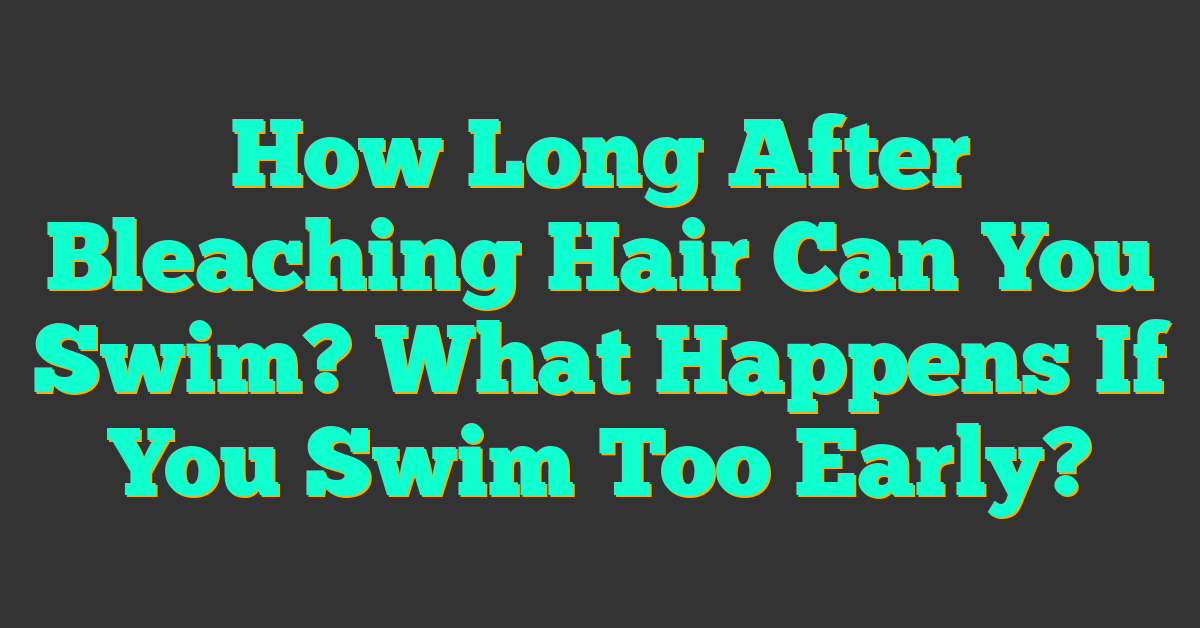If you’re planning on bleaching your hair, you may be wondering how long you should wait before swimming. After all, chlorine and saltwater can be harsh on your hair, especially when it’s been chemically treated. The good news is that you don’t have to give up swimming altogether, but you do need to take some precautions to keep your hair healthy.
First, it’s important to understand what happens when you bleach your hair. Bleaching removes the natural pigment from your hair, leaving it more porous and vulnerable to damage. Chlorine and saltwater can penetrate the hair shaft more easily when it’s been bleached, which can cause dryness, breakage, and even discoloration. That’s why it’s important to take extra care of your hair after bleaching, especially when swimming.
So, how long should you wait before swimming after bleaching your hair? The answer depends on the condition of your hair and the type of bleach you used. Most experts recommend waiting at least 24-48 hours before swimming to allow your hair to recover from the bleach and return to a stable state. However, if your hair is in poor condition or feels brittle, you may need to wait up to 7-10 days before swimming. It’s always better to err on the side of caution and wait a little longer if you’re not sure.
Key Takeaways
- Bleaching makes your hair more vulnerable to damage from chlorine and saltwater.
- Wait at least 24-48 hours before swimming after bleaching your hair, but wait longer if your hair is in poor condition.
- To protect your hair while swimming, wet it with fresh water before entering the pool or ocean, use a swim cap, and rinse it thoroughly with fresh water afterward.
Understanding Hair Bleaching
https://www.youtube.com/watch?v=XEOvJVpq198&embed=true

The Bleaching Process
Bleaching is a chemical process that removes the natural color from your hair. It involves the use of hydrogen peroxide or other chemicals to break down the melanin pigment in the hair shaft. The process can lighten your hair by several shades, but it can also damage your hair if not done correctly.
The bleaching process involves several steps. First, the hair is sectioned and the bleach mixture is applied from the roots to the ends. The mixture is left on for a certain amount of time, depending on the desired level of lightness. The hair is then rinsed thoroughly with water and a toner is applied to neutralize any remaining bleach.
Effects of Bleaching on Hair Structure
Bleaching can have a significant impact on the structure of your hair. The hair shaft is made up of three layers: the cuticle, cortex, and medulla. The cuticle is the outermost layer and serves as a protective barrier for the hair. The cortex is the middle layer and contains the pigment that gives your hair its color. The medulla is the innermost layer and is only present in some hair types.
Bleaching can cause the cuticle to become porous, which can lead to breakage and split ends. The cortex can also be damaged, causing the hair to become brittle and weak. Proteins in the hair can be broken down during the bleaching process, leading to further damage.
It is important to note that the effects of bleaching can vary depending on the condition of your hair before the process. If your hair is already damaged or dry, bleaching can make it worse. It is important to take proper care of your hair before and after bleaching to minimize damage.
Overall, bleaching can be a fun way to change up your hair color, but it is important to understand the process and potential risks before going through with it.
Pre-Swim Hair Care Tips
If you have recently bleached your hair and are planning to go for a swim, it’s important to take extra care of your hair to prevent damage. Here are some pre-swim hair care tips to keep your hair healthy and beautiful:
Moisturizing Treatments
Before you go for a swim, it’s a good idea to apply a moisturizing treatment to your hair. This will help to protect your hair from the drying effects of chlorine and saltwater. You can use a leave-in conditioner, hair mask, or deep conditioner to moisturize your hair.
If you have dry or damaged hair, you may want to consider using an oil treatment. Coconut oil, olive oil, and other hair oils are great for moisturizing and nourishing your hair. Simply apply the oil to your hair and leave it on for at least 30 minutes before washing it out.
Protective Hair Products
In addition to moisturizing treatments, you can also use protective hair products to shield your hair from the damaging effects of chlorine and saltwater. Look for hair products that contain UV filters or other protective ingredients.
You may also want to consider wearing a swim cap to protect your hair from the water. While a swim cap won’t completely prevent your hair from getting wet, it can help to minimize the amount of water that comes into contact with your hair.
By following these pre-swim hair care tips, you can help to protect your hair from damage and keep it looking healthy and beautiful.
Guidelines for Swimming After Bleaching
https://www.youtube.com/watch?v=fHwKWCsw-8I&embed=true
If you’ve recently bleached your hair and are wondering when you can go swimming, there are a few guidelines to keep in mind. While some experts recommend waiting only 24-72 hours before getting back in the water, others recommend waiting at least 7 (sometimes 10) days. Ultimately, the exact wait time will depend on the aforementioned conditions and where exactly you and your hair- both pre-bleach and post-bleach- fall on the spectrum.
Recommended Waiting Period
Most experts suggest waiting 24-48 hours before swimming. This allows your hair to return to a stable state. It also helps your hair recover from the bleach before exposing it to pool or sea water. If your hair is in good condition, you can wait 72 hours before swimming. But, it’s still not advisable to swim the same day you bleach your hair.
Swim Gear for Hair Protection
When you do decide to go swimming after bleaching your hair, it’s important to take precautions to protect your hair from further damage. One of the best ways to do this is by wearing a swim cap. Swim caps are designed to keep your hair dry and protected from the chlorine or salt water. They come in a variety of materials, including latex, silicone, and neoprene. Silicone swim caps are the most popular because they are durable and comfortable to wear.
Another way to protect your hair while swimming is to wet your hair with fresh water before getting in the pool or ocean. This helps to prevent your hair from absorbing as much chlorine or salt water. After swimming, rinse your hair with fresh water again to remove any residual chlorine or salt water. You can also use a clarifying shampoo once a week to remove any buildup from chlorine or salt water.
« How Much Do Marathon Swimmers Rest or Sleep? A Look at the Sleep Habits of Elite Swimmers
How Long After Dying Hair Can I Swim? Tips on How Swimmers Protect Their Hair »
In conclusion, while it’s tempting to jump in the pool or ocean right after bleaching your hair, it’s important to wait at least 24-48 hours before swimming. When you do decide to go swimming, make sure to wear a swim cap and rinse your hair with fresh water before and after swimming. By following these guidelines, you can enjoy swimming without damaging your newly bleached hair.
Hair Damage Prevention While Swimming
https://www.youtube.com/watch?v=Gy2Dsg7u7Zk&embed=true
Swimming is a fun activity, but it can damage your hair, especially if you have recently bleached it. Here are some tips to help you prevent hair damage while swimming.
Rinsing Techniques
Before jumping into the pool, it is important to rinse your hair with fresh water. This will help to minimize the amount of chlorine or saltwater that your hair absorbs. Wet your hair completely with fresh water, and then apply a leave-in conditioner to your hair. This will help to protect your hair from the harmful effects of chlorine or saltwater.
Post-Swim Hair Treatment
After swimming, it is important to take care of your hair to prevent damage. Rinse your hair with fresh water to remove any chlorine or saltwater residue. Use a sulfate-free shampoo to wash your hair, as sulfates can strip your hair of its natural oils. If you have been swimming in chlorinated water, use a clarifying shampoo to remove any buildup.
After shampooing, apply a deep conditioner to your hair. This will help to restore moisture and prevent damage. Leave the conditioner on your hair for at least 5 minutes, then rinse thoroughly with fresh water.
In conclusion, taking care of your hair while swimming is important to prevent damage, especially if you have recently bleached your hair. Rinse your hair before and after swimming, and use a sulfate-free shampoo and deep conditioner to keep your hair healthy. By following these tips, you can enjoy swimming without worrying about damaging your hair.
Managing Hair Condition Post-Swimming
After swimming, it is important to take care of your hair to prevent damage and maintain its health. Here are some tips to help you manage your hair condition post-swimming:
Dealing with Chlorine and Other Chemicals
Chlorine and other pool chemicals can cause hair damage, especially if you swim too early after bleaching your hair. To minimize the damage, rinse your hair with fresh water before and after swimming. This helps to remove any chemicals that may be left on your hair and scalp.
You can also use a clarifying shampoo once a week to remove any buildup of chlorine and other chemicals. Look for a shampoo that is specifically designed to remove chlorine and other pool chemicals. If you have color-treated or dyed hair, make sure to use a shampoo that is safe for your hair type.
Restoring Hair Health After Exposure
Exposure to chlorine, copper, and algaecides can make your hair feel dry and brittle. To restore your hair’s health, use a deep conditioner once a week. Look for a conditioner that contains ingredients like keratin, argan oil, or coconut oil, which can help to nourish and strengthen your hair.
If you have color-treated or dyed hair, use a conditioner that is safe for your hair type. You can also use a hair sunscreen to protect your hair from the sun’s harmful UV rays. Look for a product that contains ingredients like titanium dioxide or zinc oxide, which can help to protect your hair from damage.
In conclusion, taking care of your hair after swimming is important to prevent hair damage and maintain its health. By following these tips, you can help to keep your hair looking and feeling its best.
Frequently Asked Questions
What’s the recommended waiting period before swimming after bleaching my hair?
Most experts suggest waiting for 24-48 hours before swimming after bleaching your hair. This allows your hair to return to a stable state and recover from the bleach before exposing it to pool or sea water. However, if your hair is in good condition, you can wait up to 72 hours before swimming. It’s still not advisable to swim the same day you bleach your hair.
Can I wash my bleached hair immediately, or should I wait?
It’s best to wait at least 24 hours before washing your bleached hair. This gives your hair time to recover from the bleach and prevents further damage. When you do wash your hair, use a mild shampoo and conditioner specifically designed for bleached or colored hair. Avoid using hot water and limit the use of styling tools such as hair dryers and straighteners.
Is it safe to bleach my hair again shortly after the initial treatment?
No, it’s not safe to bleach your hair again shortly after the initial treatment. Bleaching your hair too often can cause severe damage and breakage. It’s best to wait at least 4-6 weeks before bleaching your hair again.
How does chlorine affect newly bleached hair, and can it cause discoloration?
Chlorine can cause discoloration and damage to newly bleached hair. Chlorine strips your hair of its natural oils, leaving it dry and brittle. This can cause the hair to become discolored, especially if it’s already damaged from the bleach. To prevent discoloration and damage, it’s essential to protect your hair when swimming in a pool.
What precautions should I take to protect my bleached hair when swimming in a pool?
To protect your bleached hair when swimming in a pool, wear a swim cap or apply a leave-in conditioner before entering the pool. A swim cap creates a barrier between your hair and the chlorine, while a leave-in conditioner can help to prevent damage and discoloration. After swimming, rinse your hair with clean water and apply a deep conditioning treatment to restore moisture.
If I’ve recently swum in a chlorinated pool, how long should I wait before bleaching my hair?
It’s best to wait at least 2-3 weeks before bleaching your hair after swimming in a chlorinated pool. Chlorine can cause damage and discoloration to your hair, and bleaching it too soon can worsen the damage. Give your hair time to recover and restore its natural oils before undergoing any further chemical treatments.














